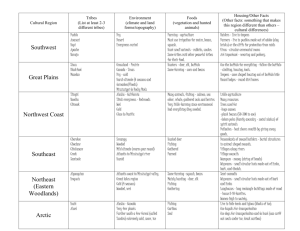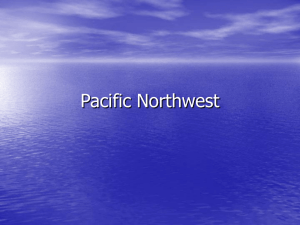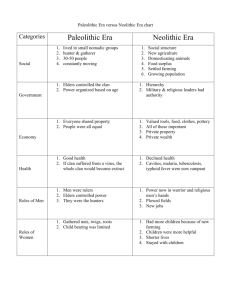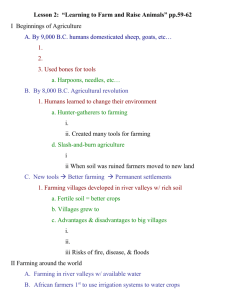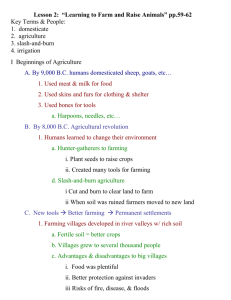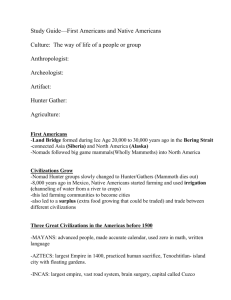Native Americans - Simpson County Schools
advertisement
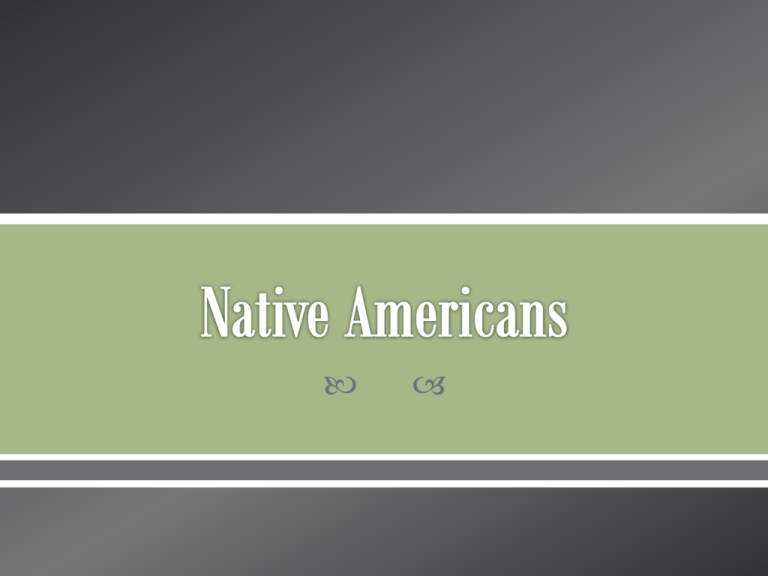
Many Thousand of years ago there was a land bridge between Asia and North America. o Present Day Russia and Alaska During the Ice Age, people were able to walk back and forth First Peoples of America were Nomads. ◦ Nomads do not have a permanent place to live. ◦ Moved with their food About 7,000 years ago they learned how to farm. ◦ Set up a community and population began to grow. ◦ The Native Americans settled in arctic ice fields, mountains, and deserts. With Farming o No longer chasing food. o Able to specialize in a certain type of job. • Weaving, Pottery, and building. Native Americans of the Arctic Inuit ( IN-oo-it) o Eskimos o “The People” Lived: o Northwestern Alaska o Northern Canada o Greenland Adapted o Changes that allowed people to survive in an environment. Housing: Inuits Adapted to their environment by created housing that helped to survive in the extreme weather. • During the winter they lived in Igloos • Animal Skinned Tents. Food o Whales, Walruses, Seals, Salmon. o Caribou, Polar Bears, Artic Foxes, o Squirrels, and Birds. o Inuits adapted by: • Eating all wildlife that was Around. Natural Resources o The Animals they captured. Used all resources from the animals o Ate the meat o Sewed animal skins for • Clothing • Blankets • Tents o Animal fat for fuel o Bones for dogsleds, tent frames, and tools • Knives • Harpoons Region: Northwest Coast ◦ Coast Alaska to California ◦ Still there today Climate: ◦ coast, mild winters, cool summers, wet climate Northwest coast- wet climate, helped a rich variety of plants to grow Long House Plank HousesLarge (up to 100 feet long) Housed several families from the same clan As many as 50 people Had rooms for storage. Tall Logs carved with many designs. 60 feet Honor families or chiefs Family History Status. ◦ Farming was difficult ◦ Due to land and climate ◦ Adapted to rely on other Natural Resources Roots and berries Gathered from the forests Fish & sea animals. From the Ocean and Rivers. An activity that everyone in the community participates in. Salmon Run Salmon swim back up the rivers in which they were born This allows them to lay eggs where they were born. Salmon◦ Important source of food ◦ A family could catch ◦ 1,000 pounds of fish To keep fish all year around: Depending on the species of salmon Roasted Dried Smoked. Fish Trap o Wooden Fence Stretched across a stream or river. o Salmon passed through the openings o Into woven baskets. Canoes o Aided in fishing Fish Hooks Fish Spears Other Natural Resources: ◦ Wood ◦ Plants ◦ Animals ◦ They were used for: ◦ Food ◦ Shelter ◦ Clothing ◦ Blankets ◦ Boats. Technology Made life easier ◦ Plenty of time for Technology ◦ Plentiful supply of Natural Resources. Due to Water Ways ◦ Tribes were able to trade with other Tribes ◦ Lots to trade because of their free time to work on technology. ◦ Made them very wealthy. Beadwork Bag Beaded Band Potlatch- ◦ special feasts ◦ Guests receive gifts ◦ Takes years to prepare This occasion for: honoring a new chief celebrate a wedding. Potlatch: ◦ Host Distributes HUNDREDS of gifts. ◦ Host gets the Respect. ◦ Each host tries to out do the other hosts. U.S. government forced Northwest Coast people to move far from the ocean 1971- a law that gave back to the Native American in Alaska over 44 million acres of their original homelands Hopiti oGentle people oTypically farmers Region: ◦ Southwest Desert ◦ Environment- land mostly made of tall mountains, deep canyons, steep mesas ◦ Mesas is an elevated area of land with a flat top and sides that are usually steep cliffs. Climate: Very dry, hardly any rain Very hot (day) Freezing (night) Blizzards and Flooding Adaptations: ◦ Dry Farming way of growing crops in places where there is little water built dams & irrigation canals. Farmed in Flood plains near and around mesas ◦ Hardy crops: corn with long roots, squash, beans, cotton. ◦ Very sacred to the Hopi everyone had a job. Natural Resources o Not many o Had to improvise with invention Adobe Bricks o Mud mixed with straw Shelter ◦ Pueblos-(villages) adobe(clay) apartment style homesprotection from heat and extreme cold To keep out intruders ◦ 1st floor of the pueblos out doors or windows used ladders was built with Kachina ceremonies Religious Belief System Spirits that visit the villages Believe they bring rain to help crops grow. Show people how to live, behave, bring peace & prosperity Ceremonies held through out the 6 months the Kachina Spirits were in the village. Each Dancer represented a differed Kachina Other dancers are Tcutckutu o They cause Mischief Takes years to train to become a dancer. Example of a Sun Kachina Represents Spirit of the Sun Main source of their survival Eagle Kachina Air Freedom Movement Nataska Feared Ogre. The Nataska make horrible noises to scare the children. From the earliest ages, Hopi children have heard o Nataska would abduct children and eat them, o The parents negotiate with the Nataska. o Parents become the hero. o Clown Kachina Represents The clown would o Misbehave o Make fun of the ceremony He would be taught a lesson o Moral of the Ceremony o Teaches children • To behave • Expectations Region: ◦ Great Plains Middle West ◦ Prairie Flat or gentle rolling land covered with grass and wildflowers. ◦ Black Hills ◦ Villages located near rivers, plenty of water for farming Climate: ◦ Summers Extremely Hot ◦ Winters Extremely Cold ◦ Lack of Rain made farming difficult Only farmed near rivers. Village Living ◦ Lodges homes made of logs covered w/ grasses, sticks, & soil. ◦ From Buffalo caught Made Beef Jerky Food ◦ Men left their villages to hunt buffalo in the summer ◦ Lived in Teepees. Teepees (adaptation) ◦ cone-shaped tents made of animals. ◦ easily folded up & moved to follow the buffalo. Travois ◦ sled-like device for carrying people & belongings Modern Made Teepee Authentic Teepee. Utilized the Buffalo with everything that they did o Teepee o Food o Clothing Horses ◦ 1500s, Spanish arrived, in NA w/ horses that changed the Plains’ lives ◦ Sioux tamed wild horses that escaped from the Spanish. ◦ Buffalo took place of farming and many stopped living in Villages. Started to live and follow the buffalo. Battles were ◦ Weapons Coup Stick- fought to prove courage. French for “strike” or “hit” used in a battle Did not strike to kill. ◦ Bow and Arrows ◦ Rifles After the Spanish. Boys Girls o Hunted with their fathers. ◦ School o School ◦ Chores o Chores ◦ Dolls o Lacross ◦ Helped mothers build houses Sun Dance 12 Day Summer Ritual Self-sacrifice. Bonding of the Men of the tribe. Dancing and inflicting wounds. Two Main Languages Spoken: ◦ Algonquian ◦ Iroquois Both Very similar to each other since they are from the same region. Region: ◦ Eastern Woodlands. ◦ Present Day North East Region. ◦ Near the top of the Appalachian Mountains. ◦ Near the Great Lakes Climate: o Humid o Wet o Cold Winters o Cool Summers o 4 distinct seasons Shelter: Iroquois where called ◦ Hoddenosaunee-”people of the longhouse” Longhouses ◦ long buildings made of poles covered w/ sheets of bark. ◦ Can be 200ft. long, provided a home for several families Common Cooking area Separate living areas a long rectangular piece of tanned deerskin, cloth, or animal fur. It is worn between the legs and tucked over a belt, so that the flaps fall down in front and behind. Sometimes it is also called a breechclout, loincloth, skin clout, or just a flap. Food(Natural Resources) o Ideal Climate for Farming • 16 types of Corn • 60 types of Beans o Women were in charge of Farming. o Forest: • Animals, Syrup, nuts, roots, vegetables, oils, fruits, berries, teas, and herbs for medicine. o Oceans provided plenty of Sea Food • Seals, Fish, Shrimp, Scallops. Technology: o Wampum (Not a Natural Resource) • consisted of small, polished beads • Usually made from shells & then strung or woven together. • Woven into a necklace or a belt. o Given as a gift on special occasions Often made to help remember an important event. Clan o Group of families who share the same ancestors Clan mother o Men were the head of each clan, • Women held a great deal of power in the Iroquois world. • Clan mothers and other clan women chose the male leaders but if unhappy replaced him. How did the different tribes have to adapt to their living environments? How did different landforms help the different tribes? What different aspects of culture did you notice from the different tribes?
